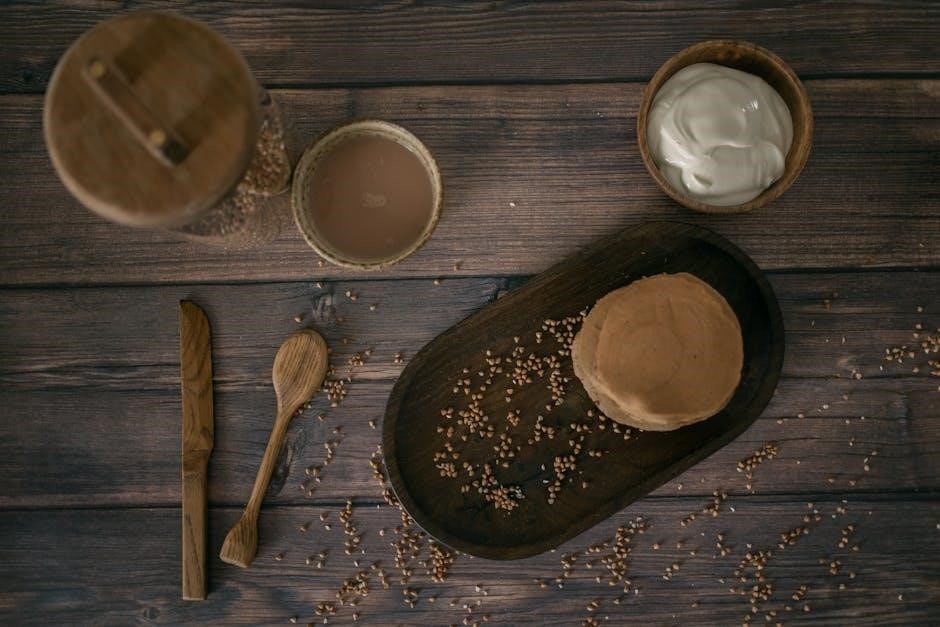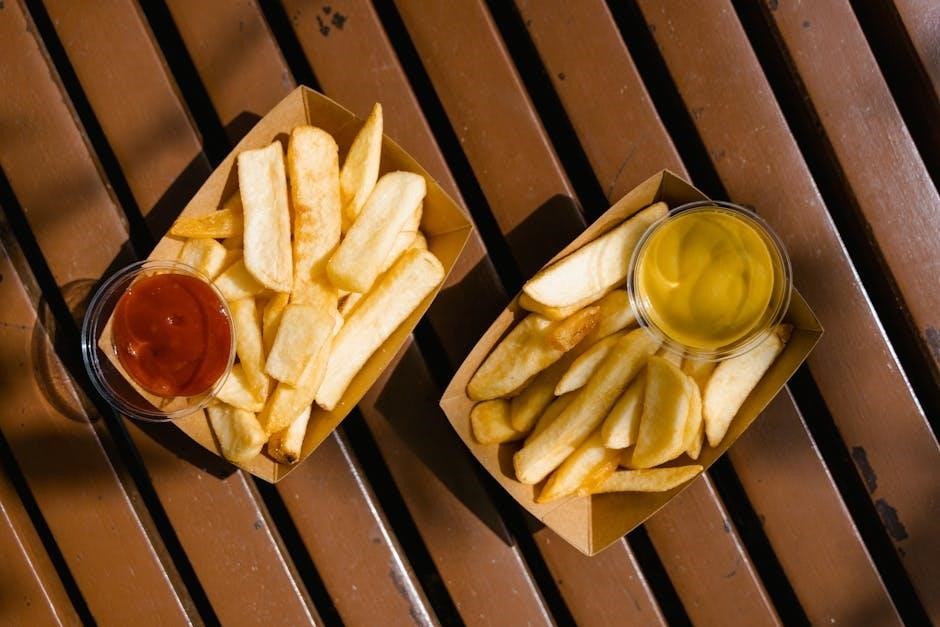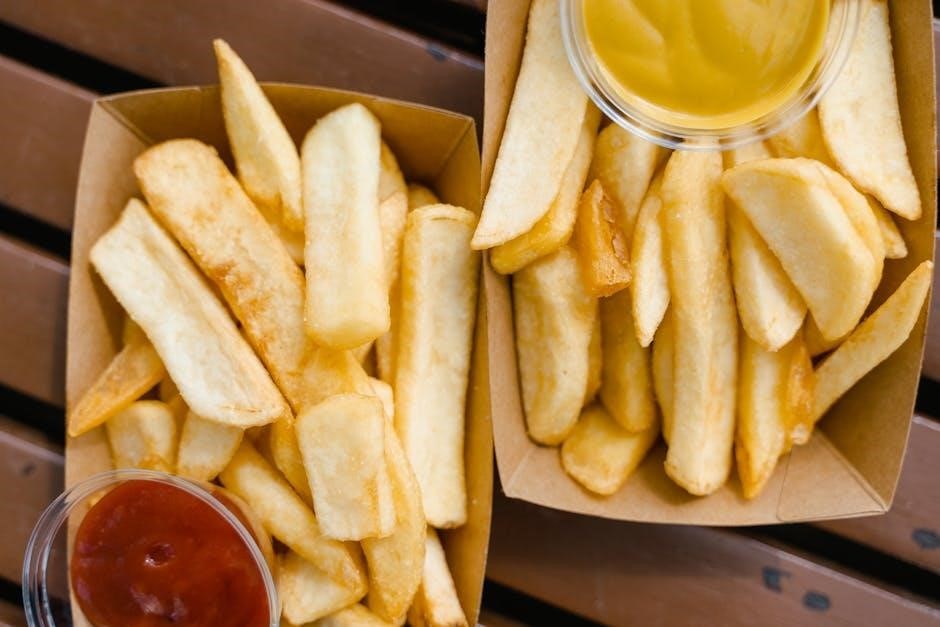A 1600 calorie meal plan is a structured approach to weight management, offering a daily intake tailored for weight loss and balanced nutrition. Designed by experts, it provides a clear guide to healthier eating habits and understanding how food impacts your body.
Overview of the 1600 Calorie Diet
The 1600 calorie diet is a structured eating plan designed for weight loss and improved health. It typically suits individuals with a lower activity level or those aiming for gradual weight reduction. This diet focuses on balancing macronutrients, emphasizing lean proteins, whole grains, and healthy fats. It encourages portion control and mindful eating to create a calorie deficit while maintaining nutritional balance. The plan is flexible, allowing for substitutions and variations to keep meals interesting and tailored to personal preferences. By adhering to this plan, individuals can develop healthier eating habits and achieve their weight goals sustainably. Regular tracking and adjustments are recommended for optimal results.
Importance of a Structured Meal Plan
A structured meal plan is essential for achieving and maintaining weight loss goals. It provides clarity and direction, ensuring that daily caloric intake stays on track. By planning meals in advance, individuals can avoid impulsive food choices and reduce the risk of overeating. A well-designed plan also promotes balanced nutrition, ensuring adequate intake of essential vitamins, minerals, and macronutrients. This structure helps in developing healthy eating habits, which are crucial for long-term success. Additionally, a structured meal plan can save time and reduce stress, making it easier to stick to the diet. Consistency is key, and a clear plan helps maintain focus and motivation throughout the journey.

Benefits of a 1600 Calorie Meal Plan

A 1600 calorie meal plan promotes steady weight loss, improves metabolic health, and enhances overall nutrition. It supports fat reduction while maintaining muscle mass, boosting energy levels and mental clarity. This structured approach helps develop sustainable eating habits, reducing the risk of chronic diseases like diabetes and heart conditions. By focusing on nutrient-dense foods, it ensures the body receives essential vitamins and minerals, fostering a healthier lifestyle. Regular physical activity complements the diet, further accelerating progress toward wellness goals. The plan is adaptable, catering to individual preferences and dietary needs, making it a versatile choice for those seeking long-term health benefits.
Weight Loss and Maintenance
A 1600 calorie meal plan is ideal for weight loss and maintenance, creating a calorie deficit while ensuring proper nutrition. By focusing on portion control and balanced meals, it helps reduce body fat without deprivation. Incorporating lean proteins, whole grains, and healthy fats supports satiety and energy levels. Regular physical activity complements the diet, enhancing fat burn and muscle tone. Tracking progress with apps like MyFitnessPal helps monitor intake and stay accountable. This plan encourages mindful eating habits, making it easier to sustain weight loss long-term. Hydration is also emphasized, as water plays a crucial role in metabolism and overall health. Consistency and patience are key to achieving and maintaining a healthy weight.
Improved Nutritional Balance
A 1600 calorie meal plan emphasizes improved nutritional balance by incorporating a variety of nutrient-dense foods. It focuses on whole, unprocessed ingredients like lean proteins, whole grains, and fiber-rich vegetables, ensuring essential vitamins and minerals are met. The plan avoids excessive sugar and unhealthy fats, promoting better overall health. By balancing macronutrients, it supports energy levels and satisfaction, reducing cravings for unhealthy snacks. Incorporating foods like nuts, seeds, and low-fat dairy provides diversity and meets dietary needs. This structured approach helps maintain a balanced diet, making it easier to adopt healthier eating habits long-term. Proper hydration, highlighted in the plan, further enhances nutritional absorption and overall well-being.

Designing Your 1600 Calorie Meal Plan
Creating a structured 1600-calorie meal plan involves tracking intake with apps like MyFitnessPal, incorporating varied recipes, and adding nuts, seeds, and healthy swaps for balanced nutrition and variety.
Understanding Daily Caloric Needs
Understanding daily caloric needs is crucial for a 1600-calorie meal plan. It involves assessing individual factors like age, weight, and activity level to determine energy expenditure. For most, 1600 calories support weight loss or maintenance. Tracking intake with tools like MyFitnessPal helps monitor consumption. Learning to read food labels ensures accurate portion control. A balanced approach includes macronutrient distribution to sustain energy and satisfaction. This knowledge helps tailor the meal plan to personal goals, ensuring it remains effective and sustainable over time without deprivation or nutrient deficiencies.
Balancing Macronutrients
Balancing macronutrients is vital for a 1600-calorie meal plan, ensuring optimal nutrition and satisfaction. Protein, found in lean sources like eggs and chicken, aids muscle maintenance and satiety. Carbohydrates, particularly whole grains, provide sustained energy and fiber. Healthy fats, such as avocados and nuts, support heart health and hormone function. A balanced ratio of these nutrients helps prevent nutrient deficiencies and keeps meals enjoyable, making the diet more sustainable. This approach ensures each meal is nutritionally complete, supporting overall health and weight management goals effectively.
Meal Prepping Tips
Meal prepping is essential for adhering to a 1600-calorie meal plan, ensuring consistency and reducing the temptation of unhealthy choices. Start by planning your meals for the week, considering portion sizes and nutrient balance. Use reusable containers to store prepared meals, keeping them fresh and easily accessible. Dedicate a specific day, like Sunday, for grocery shopping and meal preparation. Chop vegetables, cook proteins, and assemble salads or meals in advance. Utilize apps like MyFitnessPal to track calories and stay organized. Label and date meals for clarity, and refrigerate or freeze as needed. This structured approach saves time, reduces food waste, and keeps you on track with your dietary goals.

Sample 7-Day Meal Plan
A well-structured 7-day meal plan provides variety and balance, ensuring daily nutritional needs are met while staying within the 1600-calorie limit for effective weight management.
Day 1: Breakfast, Lunch, Dinner, and Snacks
Start your day with a nutritious breakfast: 2 eggs, 1 slice of whole wheat toast, and 6 oz of plain low-fat yogurt. For lunch, enjoy a mixed greens salad with 2 tbsp of Greek yogurt ranch dressing. Dinner features a piece of chicken or fish, paired with steamed vegetables like broccoli or carrots. Snacks include an apple and a handful of almonds. Stay hydrated with water or kefir throughout the day. This meal plan balances protein, fiber, and healthy fats, keeping you satisfied while adhering to the 1600-calorie goal. Portion control and variety are key to making this plan sustainable and enjoyable.
Day 2: Varied Recipes and Portions
Begin Day 2 with a protein-packed breakfast: a veggie omelet with spinach, mushrooms, and a sprinkle of cheese, served with a slice of whole grain toast. Lunch features a grilled chicken salad with mixed greens, cherry tomatoes, and a light vinaigrette. For dinner, try baked salmon with a side of quinoa and steamed asparagus. Snacks include a small handful of mixed nuts and a piece of fresh fruit. This day emphasizes variety, ensuring you meet your nutritional goals without repetition. Portion sizes are carefully balanced to keep calories in check while providing ample nutrients for energy and satisfaction throughout the day.
Day 3: Incorporating Protein and Fiber
Start Day 3 with a high-protein breakfast: Greek yogurt topped with fresh berries, chia seeds, and a drizzle of honey. Lunch features a turkey and avocado wrap in a whole wheat tortilla, paired with a side of mixed greens. Dinner includes grilled shrimp with brown rice and steamed broccoli. Snacks like a handful of almonds and an apple keep energy levels steady. This day focuses on boosting protein and fiber intake, which helps maintain muscle mass and supports digestion. The meals are designed to keep you full longer while staying within the 1600-calorie limit, ensuring a balanced and nutritious intake throughout the day.
Day 4: Healthy Alternatives and Swaps
Day 4 introduces healthier alternatives to favorite foods. Breakfast features scrambled eggs with spinach and whole wheat toast, while lunch includes a grilled chicken salad with mixed greens, cherry tomatoes, and a light vinaigrette. For dinner, try a vegetable stir-fry with tofu and brown rice. Snacks include air-popped popcorn and a small apple with peanut butter. This day emphasizes swapping high-calorie ingredients for nutrient-dense options, such as using cauliflower rice instead of regular rice or opting for whole wheat pasta. These substitutions help reduce calorie intake while maintaining flavor and satisfaction, ensuring you stay on track with your 1600-calorie goal.
Day 5: Keeping Meals Interesting
Day 5 focuses on adding variety to your meals while staying within your calorie goals. Breakfast includes Greek yogurt with mixed berries and a sprinkle of chia seeds. For lunch, try a lean turkey and avocado wrap with a side of mixed greens. Dinner features baked salmon with quinoa and steamed asparagus. Snacks include carrot sticks with hummus and a small portion of dark chocolate. To keep meals engaging, experiment with spices, herbs, and different cooking methods. Swap ingredients like using zucchini noodles instead of pasta or grilling proteins for added flavor. This approach ensures meals remain exciting and satisfying, making the 1600-calorie plan enjoyable and sustainable.
Day 6: Balancing Carbs, Fats, and Proteins
Day 6 emphasizes balancing macronutrients to ensure sustained energy and satisfaction. Breakfast includes oatmeal with almond butter and fresh berries, offering a mix of carbs, healthy fats, and protein. Lunch features a grilled chicken salad with quinoa, avocado, and olive oil dressing, blending lean protein, complex carbs, and fats. Dinner includes baked cod with brown rice and steamed vegetables, providing balanced nutrients. Snacks like a small apple with peanut butter maintain this equilibrium. This day’s meals are designed to showcase how carbs, fats, and proteins can work together to keep you nourished and energized, while staying within your 1600-calorie goal.
Day 7: Final Adjustments and Reflections
Day 7 focuses on final adjustments and reflections. Begin with scrambled eggs, spinach, and whole-grain toast for breakfast, providing a protein-packed start. Lunch features a mixed greens salad with grilled chicken and olive oil dressing, ensuring a balance of carbs, fats, and proteins. Dinner includes baked salmon, roasted vegetables, and quinoa, offering a nutritious finish to the week. Snacks like baby carrots and a small apple with almond butter keep energy levels steady. Reflect on your progress, adjust portion sizes as needed, and celebrate small victories. Stay hydrated, incorporate light exercise, and review your food diary to identify patterns. This reflection will help you make informed adjustments for continued success on your 1600-calorie journey.
Key Foods to Include
Emphasize lean proteins, whole grains, and healthy fats. These foods help satisfy hunger, provide sustained energy, and support overall health on a 1600-calorie diet.
Lean Proteins and Their Role
Lean proteins are essential for muscle maintenance and satiety. Include sources like chicken, turkey, fish, tofu, and legumes. These foods provide essential amino acids and help sustain energy levels. Portion control is key to staying within the 1600-calorie limit. Aim for 3-4 ounces per serving. Lean proteins also support metabolism and weight loss by preserving muscle mass. Incorporate variety to keep meals interesting and ensure adequate protein intake. Eggs, Greek yogurt, and cottage cheese are also excellent options. Pairing proteins with vegetables or whole grains creates balanced meals. Protein-rich foods help reduce cravings and keep you fuller longer, making them a cornerstone of the meal plan.
Whole Grains and Fiber-Rich Foods
Whole grains and fiber-rich foods are vital for a balanced diet. They provide essential nutrients, vitamins, and minerals while promoting digestive health. Incorporate options like brown rice, quinoa, oats, barley, whole wheat bread, and whole grain pasta. Fiber-rich vegetables such as broccoli, spinach, and Brussels sprouts add variety. Legumes, including beans, lentils, and chickpeas, are also excellent sources. Fiber helps with satiety and blood sugar control, making it easier to stick to the meal plan. Pair whole grains with lean proteins or healthy fats for satisfying meals. These foods support long-term energy levels and overall well-being, ensuring a nutritious foundation for your 1600-calorie journey.
Healthy Fats and Their Importance
Healthy fats are essential for a balanced diet, providing sustained energy and supporting heart health. Incorporate sources like avocados, nuts, seeds, and olive oil. These fats enhance nutrient absorption and contribute to satiety. Avocados add creaminess to meals, while nuts and seeds offer a satisfying crunch. Use olive oil for dressings or cooking. Even small portions of healthy fats can reduce cravings and support overall well-being. Pair them with whole grains or lean proteins for balanced meals. Including a variety of these fats ensures you meet dietary needs while keeping meals flavorful and nutritious.

Hydration and Physical Activity
Staying hydrated is crucial for metabolism and energy. Aim for at least 8 cups of water daily. Pair this with regular physical activity to enhance weight loss and overall health.
The Role of Water in Weight Loss
Water plays a vital role in weight loss by boosting metabolism and aiding in calorie burn. Even mild dehydration can slow down metabolic rates, making it harder to lose weight. Drinking water helps suppress appetite and reduces cravings, preventing overeating. It also supports digestion and nutrient absorption, ensuring your body functions optimally. Aim for at least 8 cups (64 ounces) of water daily, adjusting for activity levels and climate. Incorporating water-rich foods like fruits and vegetables can also contribute to hydration. Staying hydrated not only supports weight loss but also enhances overall health and energy levels throughout your journey.
Exercise Recommendations
Regular physical activity is crucial for enhancing the effectiveness of a 1600 calorie meal plan. Aim for at least 150 minutes of moderate-intensity aerobic exercises, such as brisk walking or cycling, per week. Incorporate strength training sessions 2-3 times weekly to build muscle and boost metabolism. High-intensity interval training (HIIT) can also accelerate fat loss and improve cardiovascular health. Pairing exercise with your meal plan helps create a calorie deficit, essential for weight loss. Additionally, activities like swimming or yoga can enhance flexibility and overall well-being. Consistency is key, so find routines you enjoy and stick to them for sustainable results. Always consult a fitness professional to tailor workouts to your goals and fitness level.

Tracking Your Progress
Monitor your daily food intake and physical activity using a food diary or apps like MyFitnessPal. Regularly track weight, measurements, and progress photos to stay motivated and make necessary adjustments for sustained success.
Using a Food Diary
A food diary is a powerful tool for tracking your daily food intake, helping you stay accountable and aware of your eating habits. By listing everything you consume, including portion sizes and calories, you can identify patterns, make healthier choices, and monitor progress. Digital apps like MyFitnessPal simplify this process, allowing you to log meals and recipes effortlessly. A food diary also helps you set realistic goals and celebrate small victories, keeping you motivated on your weight loss journey. Consistency is key—regularly updating your diary ensures you stay on track and maintain long-term success with your 1600 calorie meal plan.
Monitoring Weight and Measurements
Regularly monitoring your weight and body measurements is essential for tracking progress on your 1600 calorie meal plan. Weigh yourself weekly and take note of any changes, ensuring you stay on course with your goals. In addition to weight, measure key areas like waist, hips, and arms to see improvements in body composition. Progress photos can also provide visual motivation. This consistent tracking helps identify patterns and allows for timely adjustments to your diet or exercise routine. By celebrating small milestones, you’ll stay motivated and committed to your journey. Monitoring not only measures physical changes but also reinforces the effectiveness of your meal plan.

Common Challenges and Solutions
Hunger and cravings can be managed with healthy snacks like nuts or fruits. Stay motivated by celebrating small milestones and using apps like MyFitnessPal for tracking progress.
Dealing with Hunger and Cravings
Hunger and cravings are common challenges on a 1600 calorie meal plan. To manage these, incorporate protein-rich foods like eggs, lean meats, and Greek yogurt, which help keep you full longer. Snacking on fiber-rich options such as mixed greens salads with Greek yogurt ranch dressing and nuts can also curb cravings. Staying hydrated by drinking water or alternatives like kefir or coconut milk may reduce hunger pangs. Additionally, meal prepping and tracking your intake with apps like MyFitnessPal can help maintain discipline and prevent overeating. Balancing meals with whole grains, fruits, and vegetables ensures sustained energy levels and reduces the likelihood of unhealthy cravings.
Maintaining Motivation
Maintaining motivation on a 1600 calorie meal plan requires consistent effort and positive mindset. Tracking progress through food diaries or apps like MyFitnessPal can help stay accountable and motivated. Setting small, achievable goals, such as weekly weight loss targets, can provide a sense of accomplishment. Celebrating non-scale victories, like increased energy or better sleep, also boosts morale. Staying positive and reminding yourself of long-term health benefits is key. Planning meals in advance and having a support system can further enhance motivation. Lastly, rewarding yourself with non-food treats or activities can keep the journey enjoyable and sustainable.

Final Thoughts
A 1600 calorie meal plan promotes sustainable weight loss and improved health when paired with hydration, exercise, and mindful tracking. Stay committed and consult a dietitian for personalized success.
Long-Term Sustainability
Adopting a 1600 calorie meal plan as a lifestyle rather than a quick fix ensures long-term sustainability. Focus on gradual changes, incorporating varied recipes and balanced nutrition to avoid monotony. Prioritize whole foods, lean proteins, and fiber-rich options to maintain satisfaction and energy levels. Regular hydration and physical activity complement the diet, supporting overall health. Tracking progress through food diaries or apps like MyFitnessPal helps maintain accountability and motivation. Consulting a dietitian can provide personalized adjustments, ensuring the plan aligns with your goals and health needs. Over time, this structured approach fosters healthier habits, making weight loss and improved wellness a sustainable reality.
Consulting a Dietitian
Consulting a registered dietitian is a crucial step in tailoring the 1600 calorie meal plan to your specific needs. A dietitian can assess your health goals, lifestyle, and dietary preferences to create a personalized plan. They ensure macronutrient balance, address potential nutrient deficiencies, and offer guidance on managing special dietary requirements. A dietitian also provides ongoing support to help you stay motivated and address challenges. Their expertise ensures the plan is sustainable and aligns with your long-term health objectives. By leveraging their knowledge, you can make informed decisions and achieve a balanced, effective approach to weight loss and improved nutrition.
